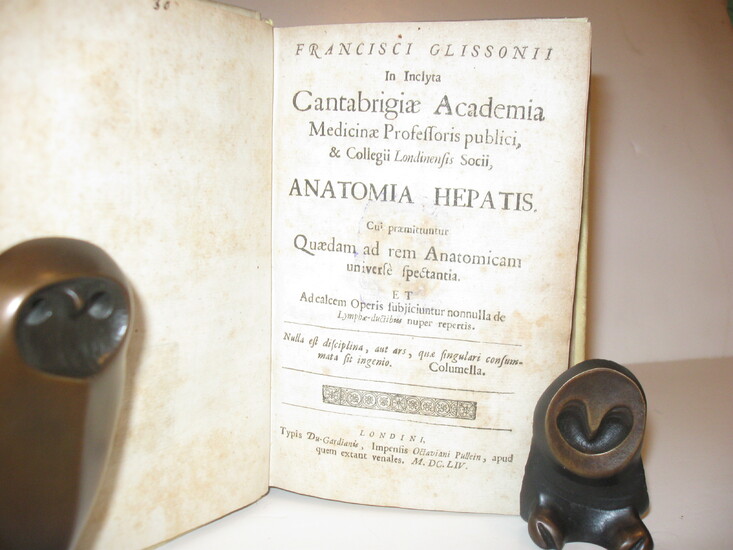Anatomia Hepatis. Cui Praemittuntur quaedam ad Rem Anatomicam Universe Spectantia. HASKELL NORMAN'S COPY: FIRST EDITION
By GLISSON, Francis
24 leaves, 458 pp, 7 leaves; 2 engraved plates; text illus. Contemporary vellum. Ink stamp on verso of title page and on p. 458. Text browned. Very Good. First Edition. A complete copy, with both plates and all text leaves. Garrison-Morton 972. "Glisson's classic work on the liver, Anatomia Hepatis . . . made fundamental contributions to understanding the physiology of abdominal organs, in that it delineated the structure and function of the liver, and identified and described the fibrous tissue encasing the liver (Glisson's capsule). It also introduced Glisson's important concept of 'irritability' in which he argued that irritation was the organism's way of recognizing substrances to be expelled. . . . Glisson's works, particularly the Anatomia Hepatis remapped and reconceived physiology very much in the spirit of Harvey" (Grolier, Medicine 29). Garrison-Morton 1098.1: "Independently of Bartholin and Rudbeck, George Joyliffe observed the lymphatics. He communicated his discovery to Glisson early in 1652 and the latter included an account in the above work (Cap. xxxi)." Grolier, Medicine 29. Norman 911 (this copy). LeFanu, Notable Medical Books from the Lilly Library, p. 67. Heirs of Hippocrates 472.
Published by: London: Typis Du-Gardianis, Impensis Octaviani Pullein, 1654., 1654
Vendor: Scientia Books, ABAA ILAB
Buy Now on
By GLISSON, Francis
24 leaves, 458 pp, 7 leaves; 2 engraved plates; text illus. Contemporary vellum. Ink stamp on verso of title page and on p. 458. Text browned. Very Good. First Edition. A complete copy, with both plates and all text leaves. Garrison-Morton 972. "Glisson's classic work on the liver, Anatomia Hepatis . . . made fundamental contributions to understanding the physiology of abdominal organs, in that it delineated the structure and function of the liver, and identified and described the fibrous tissue encasing the liver (Glisson's capsule). It also introduced Glisson's important concept of 'irritability' in which he argued that irritation was the organism's way of recognizing substrances to be expelled. . . . Glisson's works, particularly the Anatomia Hepatis remapped and reconceived physiology very much in the spirit of Harvey" (Grolier, Medicine 29). Garrison-Morton 1098.1: "Independently of Bartholin and Rudbeck, George Joyliffe observed the lymphatics. He communicated his discovery to Glisson early in 1652 and the latter included an account in the above work (Cap. xxxi)." Grolier, Medicine 29. Norman 911 (this copy). LeFanu, Notable Medical Books from the Lilly Library, p. 67. Heirs of Hippocrates 472.
Published by: London: Typis Du-Gardianis, Impensis Octaviani Pullein, 1654., 1654
Vendor: Scientia Books, ABAA ILAB



